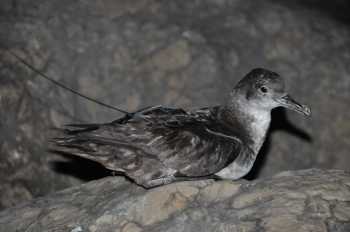The Balearic Shearwater Puffinus mauretanicus is a newly-listed ACAP species. Maite Louzao (Centro Oceanográfico de Xixón, Instituto Español de Oceanografía, Xixón, Spain) and colleagues writing on-line in the open-access journal PloS One have used satellite trackers to look at where the species goes during the breeding season, concluding that "[t]ransboundary conservation efforts are needed for the critically endangered Balearic shearwater."
The paper's abstract follows:
‘The protection of key areas for biodiversity at sea is not as widespread as on land and research investment is necessary to identify biodiversity hotspots in the open ocean. Spatially explicit conservation measures such as the creation of representative networks of marine protected areas (MPAs) is a critical step towards the conservation and management of marine ecosystems, as well as to improve public awareness. Conservation efforts in ecologically rich and threatened ecosystems are specially needed. This is particularly urgent for the Mediterranean marine biodiversity, which includes highly mobile marine vertebrates. Here, we studied the at sea distribution of one of the most endangered Mediterranean seabird, the critically endangered Balearic shearwater Puffinus mauretanicus. Present knowledge, from vessel-based surveys, suggests that this species has a coastal distribution over the productive Iberian shelf in relation to the distribution of their main prey, small pelagic fish. We used miniaturised satellite transmitters to determine the key marine areas of the southern population of Balearic shearwaters breeding on Eivissa and spot the spatial connections between breeding and key marine areas. Our tracking study indicates that Balearic shearwaters do not only forage along the Iberian continental shelf but also in more distant marine areas along the North African coast, in particular W of Algeria, but also NE coast of Morocco. Birds recurrently visit these shelf areas at the end of the breeding season. Species distribution modelling identified chlorophyll a as the most important environmental variable in defining those oceanographic features characterizing their key habitats in the western Mediterranean. We identified persistent oceanographic features across time series available in the study area and discuss our results within the current conservation scenario in relation to the ecology of the species."

Balearic Shearwater with a back-mounted satellite tag
Photograph by Henri Weimerskirch
Reference:
Louzao, M., Delord, K., García, D., Boué, A. & Weimerskirch, H. 2012. Protecting persistent dynamic oceanographic features: transboundary conservation efforts are needed for the Critically Endangered Balearic Shearwater. PLoS One 7(5): e35728. doi:10.1371/journal.pone.0035728.
Click here for a press release on the study.
With thanks to Maite Louzao, ACAP European News Correspondent, for information.
John Cooper, ACAP Information Officer, 27 May 2012

 English
English  Français
Français  Español
Español